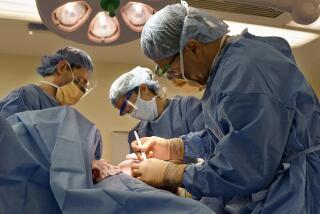Breast, ovary removal found to raise cancer survival rates
Preemptive removal of breasts or ovaries in women with two common breast cancer genes can sharply reduce the risk of contracting cancer and dying, even if a woman has already been diagnosed with breast cancer, a new study confirms.
Researchers were already confident that such prophylactic surgeries reduce the risk of cancer, but the new study, reported Tuesday in the Journal of the American Medical Assn., is the largest such investigation to date and the first to differentiate the benefits based on which gene a woman has and whether or not she has already had cancer. It is also the first to show a survival benefit.
Removal of the ovaries and ovarian tubes in women with either the BRCA1 or BRCA2 genes can almost completely eliminate the risk of ovarian cancer and reduce the risk of breast cancer by about two-thirds, the study found. Removal of breasts can reduce the risk of breast cancer by as much as 85%. Either procedure reduces the risk of dying by at least two-thirds.
“We already knew intuitively that removing breasts reduces the risk of breast cancer, but this is the first paper that actually shows it contributes to a survival benefit,” said Dr. Jane Kakkis, surgical director at MemorialCare Breast Center at Orange Coast Memorial Medical Center in Fountain Valley, who was not involved in the study. “That’s a big difference in terms of helping patients make a difficult decision.”
“This paper reminds us that genetic testing can save lives,” added Dr. Kenneth Offit, chief of the clinical genetics service at Memorial Sloan-Kettering Cancer Center in New York, who also was not involved in the study. “If a woman or a man has a family history of breast, ovarian or prostate cancer, it is wise to speak to a physician about genetic testing [which can] lead to surgical options that will decrease the risk of subsequent cancer.”
Women who have either of the two BRCA genes have a lifetime risk of 56% to 84% of developing breast cancer. Women with the BRCA1 gene also have a 36% to 63% risk of ovarian cancer, and those with BRCA2 have a 10% to 27% risk.
Prophylactic mastectomies sharply reduce the risk of breast cancer by surgically removing the bulk of tissue in which such tumors arise. Prophylactic removal of the ovaries and tubes, a procedure called salpingo-oophorectomy, not only nearly eliminates the risk of ovarian cancer by removing virtually all of the tissue in which it can arise, but also reduces the risk of breast cancer by sharply reducing the production of estrogen, which fuels the growth of breast tumors.
Most physicians now recommend that breast removal be considered anytime after the presence of the genes has been diagnosed. For patients who reject mastectomies for aesthetic or sexual reasons, the alternative is more intensive screening, with a mammogram or an MRI every six months. That is especially important for carriers of the BRCA1 gene, which is associated with a more aggressive, fast-growing form of breast cancer.
The vast majority of physicians recommend salpingo-oophorectomies for BRCA carriers once they are done having children, because there is simply no good alternative.
“That is the single most important intervention that we can do,” said Dr. Jeffrey Weitzel of the City of Hope Medical Center in Duarte, who participated in the study.
Kakkis said that the greatest risk with the procedure is surgically induced menopause, but that studies have shown that even when hormone replacement therapy is used, the risk of cancer is still reduced by at least half.
In the study, a team headed by Drs. Timothy R. Rebbeck and Susan M. Domchek of the University of Pennsylvania School of Medicine studied 2,482 women who had been diagnosed as BRCA carriers between 1974 and 2008. About 10% chose to have mastectomies and about 40% salpingo-oophorectomies, although there was some overlap between the two groups. More than half had neither procedure.
The most impressive results involved ovary removal. About 1% of women who had them removed were later diagnosed with ovarian cancer — mostly in tissue that surgeons had missed — compared with 6% of those who did not undergo surgery. Eleven percent of those who had their ovaries removed were diagnosed with breast cancer, compared with 19% of those who had no surgery. Three percent died of all causes, compared with 10% of those who had no surgery.
The main thing the study shows, Rebbeck said, is that “if you are a woman in this situation, there is something you can do to reduce your risk of dying from cancer.”






